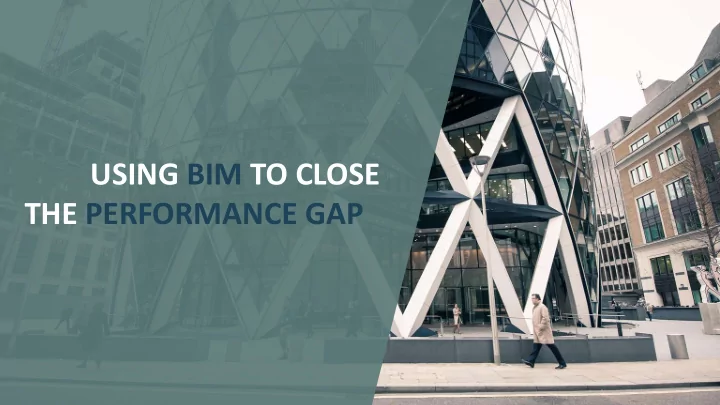

USING BIM TO CLOSE THE PERFORMANCE GAP
Introduction
There is a gap in performance! There is a mismatch between the expectations around the performance of new buildings and the reality of utility bills. This difference between expected and realised energy performance has come to be known as the « performance gap »
There is a gap in performance! There are many reasons for this: 1. Building energy modelling difficulties during design 2. Changes to the specification during construction 3. Squeezed commissioning period leading to incomplete work 4. Unanticipated occupant behaviour or changes in building use
Strategies Make more realistic expectations Build closer to design Actual Actual BEM BEM Building Building
Agenda Building Energy Model 1. BIM and design (BEM) a) Using BIM to populate BEM b) Feeding back BEM results to BIM Building 2. Updating BEM with BMS (model calibration) Management System 3. Improving actual building with BEM conclusions 4. Using newly acquired knowledge for design
BIM and Design
VIRTUAL ENVIRONMENT
BIM 4 Analysis Actual BEM BIM Building
BIM 4 Analysis gbXML, Excel
BIM 4 Analysis
Model calibration
Model calibration
Model calibration 30% Reduction in Lighting Load Goes up to 65% in offices 62% Reduction in Equipment Load Goes up to 65% in offices
Model calibration The combined impact of the actual equipment on the annual boiler energy compared with the Compliance profiles is shown below Compliance model predicted 34% less heating energy when compared to the calibrated model
Bridging the Discrepancy Actual Dynamic Simulation Model + Building Operational Data Gap between predicted and actual performance can be closed to 5-10%
Case study: NHS Trust in London • Measured consumption data compared to results from initial Enhanced Model • Electricity Usage from Motor Control Centres (MCCs) and per floor panels & Half Hourly gas data • Simulation parameters in the Enhanced Model were tweaked to provide a close match to measured consumption Simulated Electrical Consumption against measured electrical consumption – Nov 2015.
Case study: NHS Trust in London Model calibrated to a Monthly level, but IES was also able to calibrate the Electricity to an Hourly level Benchmark Model Results End Use CVRMSE NMBE Electricity (Monthly) 2.1 -0.4 Electricity (Hourly) 14.3 -0.8 Gas (Monthly) 8.6 0.4 HVAC (Monthly) 6.1 -3.4 Small Power (Monthly) 2.5 2.2 ASHRAE Guideline 14: Model is “calibrated” when the Coefficient of Variance Root Mean Square Error (CVRMSE) is below 15% and Net Mean Bias Error (NMBE) is ± 5% for monthly calibration. If hourly calibration data is used, these requirements shall be 30% and 10% respectively.
Improving actual building
Using Calibrated BEM • Identify underperforming parameters • Detect faults • Test possible improvements (retrofit)
Build deeper knowledge
Using acquired knowledge • To make better BEM at design stage • Occupancy • Equipment • Imperfect controls • To investigate so far neglicted improvement areas
SUMMARY
Using BIM to close the performance gap • BIM is used to populated initial BEM • BEM updates BIM on critical points • BMS used to calibrate BEM • Calibrated BEM used to control building operation, investigate options for improvements • More reliable information used for initial BEM at design stage
Johan Haeberle Johan.haeberle@iesve.com +33 610 533 265 www.iesve.com www.iesve.com/DiscoverIES
Recommend
More recommend